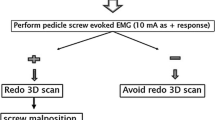Abstract
Study Design
Experimental study
Objectives
To document and analyze the neurophysiological changes during spinal cord monitoring when thoracic pedicle screws are intentionally placed within the spinal canal.
Summary of Background Data
Although the rate of misplaced screws is relatively high, few patients have neurological impairment. This suggests that a significant degree of medullary displacement and/or compression is necessary to produce neurophysiological changes.
Methods
The spinal cord of 3 experimental pigs was surgically exposed at 3 different levels (T11, T9, and T6). Two pedicle screws were placed within the spinal canal at each vertebral level under direct vision. One was placed on the lateral edge of the dural sac, causing only a slight cord displacement; a second screw was placed in the middle of the spinal canal, producing marked displacement of the neural structures. During the procedure, neurophysiological monitoring of the spinal cord was performed.
Results
No neurophysiological changes were observed in any screws placed at the lateral edge of the dural sac for 20 minutes after screw placement. When the screws were placed in the center of the spinal canal, neurophysiological changes occurred with a mean latency of 10.1 ± 2.1 minutes, and at 11.6 ± 1.9 minutes there was complete loss of the spinal cord evoked potentials in all cases. After these centered screws were removed, evoked potentials began to recover, with a latency of 9.7 ± 3.0 minutes in 7 of 9 cases.
Conclusions
Neurophysiological monitoring of the spinal cord does not detect moderate compression even 20 minutes after neural compression. Only thoracic pedicle screws provoking marked displacement of the spinal cord were able to cause delayed neurophysiological changes leading to loss of spinal cord evoked potentials, which in 22% of cases did not recover after the pedicle screw was removed.
Similar content being viewed by others
References
Burgos J, Riquelme O, Barrios C, et al. No changes in the asymmetric location of the spinal cord within the vertebral canal after correction of thoracic scoliosis: a clinical and experimental study. Paper presented at: 14th International Meeting on Advanced Spine Techniques; July 11–14, 2007; Bahamas.
Danesh-Clough T, Taylor P, Hodgson B, et al. The use of evoked EMG in detecting misplaced thoracolumbar pedicle screws. Spine (Phila Pa 1976) 2001;26:1313–6.
Raynor BL, Lenke LG, Kim Y, et al. Can triggered electromyograph thresholds predict safe thoracic pedicle screw placement? Spine (Phila Pa 1976) 2002;27:2030–5.
Reidy DP, Houlden D, Nolan PC, et al. Evaluation of electromyographic monitoring during insertion of thoracic pedicle screws. J Bone Joint Surg Br 2001;83:1009–14.
Shi YB, Binette M, Martin WH, et al. Electrical stimulation for intraoperative evaluation of thoracic pedicle screw placement. Spine (Phila Pa 1976) 2003;28:595–601.
Rodriguez-Olaverri JC, Zimick NC, Merola A, et al. Using triggered electromyographic threshold in the intercostal muscles to evaluate the accuracy of upper thoracic pedicle screw placement (T3-T6). Spine (Phila Pa 1976) 2008;33:E194–7.
Hicks JM, Singla A, Shen FH, Arlet V. Complications of pedicle screw fixation in scoliosis surgery: a systematic review. Spine (Phila Pa 1976) 2010;35:465–70.
Kuklo TR, Lenke LG, O’Brien MF, et al. Accuracy and efficacy of thoracic pedicle screws in curves more than 90°. Spine (Phila Pa 1976) 2005;30:222–6.
Smorgick Y, Millgram MA, Anekstein Y, et al. Accuracy and safety of thoracic pedicle screw placement in spinal deformities. J Spinal Disord Tech 2005;18:522–6.
Lehman Jr RA, Lenke LG, Keeler KA, et al. Computed tomography evaluation of pedicle screws placed in the pediatric deformed spine over an 8-year period. Spine (Phila Pa 1976) 2007;32:2679–84.
Antón Rodrigalvarez LM, Montes E, Burgos J, et al. Neurophysiological monitoring signal with thoracic pedicle screws placed within the spinal canal: an experimental study in pigs. Paper presented at: 46th annual meeting and course, Scoliosis Research Society; September 14–17, 2011; Louisville, KY.
Wadouh F, Arndt CF, Metzger H, et al. Direct measurements of oxygen tension on the spinal cord surface of pigs after occlusion of the descending aorta. J Thorac Cardiovasc Surg 1985;89:787–94.
De Blas G, Barrios C, Regidor I, et al. Safe pedicle screw placement in thoracic scoliotic curves using t-EMG: stimulation threshold variability at concavity and convexity in apex segments. Spine (Phila Pa 1976) 2012;37:E387–95.
Author information
Authors and Affiliations
Corresponding author
Additional information
This investigation was presented at the 46th annual meeting of the Scoliosis Research Society in Louisville, Kentucky.
Author disclosures: MAR (none); CB (none); GD (none), JB (none); EH (none); CC (none).
The Research Foundation of Hospital Ramón y Cajal, Madrid, provided funding for this work.
Rights and permissions
About this article
Cite this article
Antón-Rodrigálvarez, M., Barrios, C., de Blas, G. et al. Intraoperative Neurophysiological Changes Induced by Thoracic Pedicle Screws Intentionally Placed Within the Spinal Canal: An Experimental Study in Pigs. Spine Deform 2, 89–94 (2014). https://doi.org/10.1016/j.jspd.2013.11.005
Received:
Revised:
Accepted:
Published:
Issue Date:
DOI: https://doi.org/10.1016/j.jspd.2013.11.005




